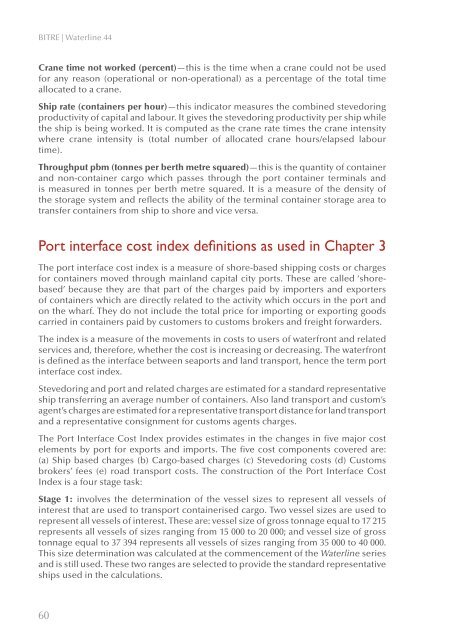PDF: 1352 KB - Bureau of Infrastructure, Transport and Regional ...
PDF: 1352 KB - Bureau of Infrastructure, Transport and Regional ...
PDF: 1352 KB - Bureau of Infrastructure, Transport and Regional ...
- No tags were found...
You also want an ePaper? Increase the reach of your titles
YUMPU automatically turns print PDFs into web optimized ePapers that Google loves.
BITRE | Waterline 44Crane time not worked (percent)—this is the time when a crane could not be usedfor any reason (operational or non-operational) as a percentage <strong>of</strong> the total timeallocated to a crane.Ship rate (containers per hour)—this indicator measures the combined stevedoringproductivity <strong>of</strong> capital <strong>and</strong> labour. It gives the stevedoring productivity per ship whilethe ship is being worked. It is computed as the crane rate times the crane intensitywhere crane intensity is (total number <strong>of</strong> allocated crane hours/elapsed labourtime).Throughput pbm (tonnes per berth metre squared)—this is the quantity <strong>of</strong> container<strong>and</strong> non-container cargo which passes through the port container terminals <strong>and</strong>is measured in tonnes per berth metre squared. It is a measure <strong>of</strong> the density <strong>of</strong>the storage system <strong>and</strong> reflects the ability <strong>of</strong> the terminal container storage area totransfer containers from ship to shore <strong>and</strong> vice versa.Port interface cost index definitions as used in Chapter 3The port interface cost index is a measure <strong>of</strong> shore-based shipping costs or chargesfor containers moved through mainl<strong>and</strong> capital city ports. These are called ‘shorebased’because they are that part <strong>of</strong> the charges paid by importers <strong>and</strong> exporters<strong>of</strong> containers which are directly related to the activity which occurs in the port <strong>and</strong>on the wharf. They do not include the total price for importing or exporting goodscarried in containers paid by customers to customs brokers <strong>and</strong> freight forwarders.The index is a measure <strong>of</strong> the movements in costs to users <strong>of</strong> waterfront <strong>and</strong> relatedservices <strong>and</strong>, therefore, whether the cost is increasing or decreasing. The waterfrontis defined as the interface between seaports <strong>and</strong> l<strong>and</strong> transport, hence the term portinterface cost index.Stevedoring <strong>and</strong> port <strong>and</strong> related charges are estimated for a st<strong>and</strong>ard representativeship transferring an average number <strong>of</strong> containers. Also l<strong>and</strong> transport <strong>and</strong> custom’sagent’s charges are estimated for a representative transport distance for l<strong>and</strong> transport<strong>and</strong> a representative consignment for customs agents charges.The Port Interface Cost Index provides estimates in the changes in five major costelements by port for exports <strong>and</strong> imports. The five cost components covered are:(a) Ship based charges (b) Cargo-based charges (c) Stevedoring costs (d) Customsbrokers’ fees (e) road transport costs. The construction <strong>of</strong> the Port Interface CostIndex is a four stage task:Stage 1: involves the determination <strong>of</strong> the vessel sizes to represent all vessels <strong>of</strong>interest that are used to transport containerised cargo. Two vessel sizes are used torepresent all vessels <strong>of</strong> interest. These are: vessel size <strong>of</strong> gross tonnage equal to 17 215represents all vessels <strong>of</strong> sizes ranging from 15 000 to 20 000; <strong>and</strong> vessel size <strong>of</strong> grosstonnage equal to 37 394 represents all vessels <strong>of</strong> sizes ranging from 35 000 to 40 000.This size determination was calculated at the commencement <strong>of</strong> the Waterline series<strong>and</strong> is still used. These two ranges are selected to provide the st<strong>and</strong>ard representativeships used in the calculations.60
















